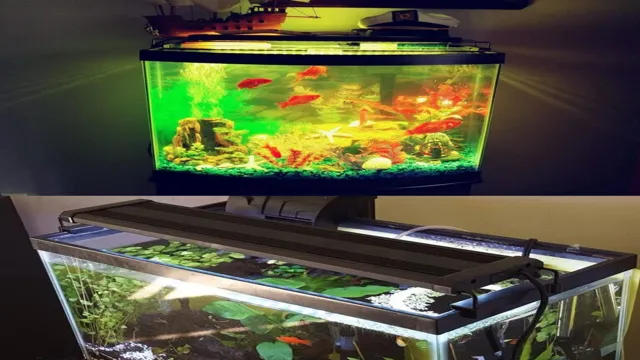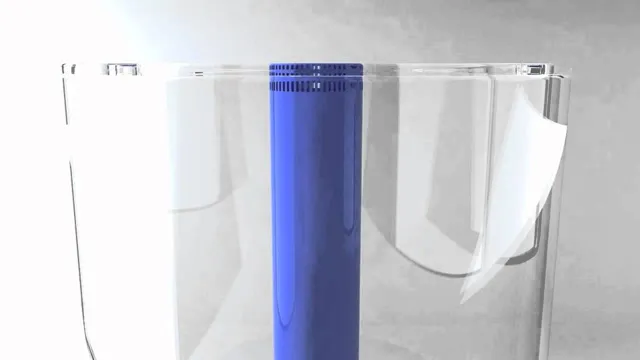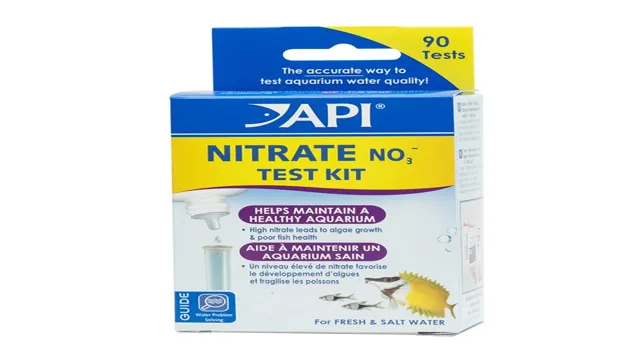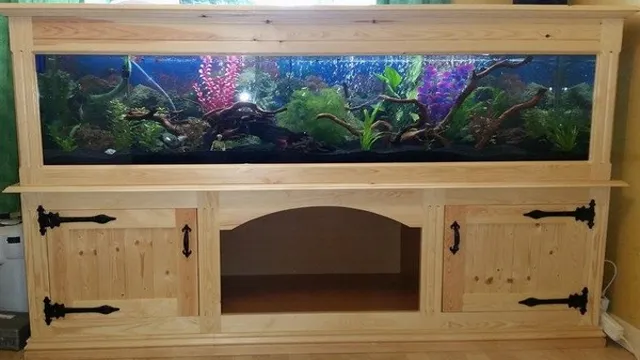If you’re a proud aquarium owner, you know that providing the right environment for your underwater pets is vital to their health and happiness. And part of that environment is the aquarium hood. It helps regulate the temperature, prevent debris from falling into the tank, and most importantly, provides lighting for your aquatic flora and fauna.
But what do you do when the LED lights in your aquarium hood start to dim or burn out? Don’t worry, changing them is easier than you think. In this step-by-step guide, we’ll walk you through how to change the LED lights in your aquarium hood and ensure your fish and plant life continue to flourish. So, let’s dive in and get started!
What You’ll Need
If you’re looking to upgrade your aquarium hood with new LED lights, there are a few things you’ll need before getting started. First, you’ll need to determine how many lights you need based on the size of your tank and the specific needs of the plants and fish inside. You’ll also need to purchase replacement LED lights that fit your hood, as not all lights are created equal.
Additionally, you’ll need any necessary tools such as a screwdriver if the hood needs to be disassembled for the new lights to be installed. Before you begin, be sure to read the instructions thoroughly and take the necessary safety precautions. With the right tools and a little bit of know-how, changing the LED lights in your aquarium hood can be a simple and rewarding DIY project.
LED lights
When it comes to LED lights, there are a few things you’ll need to get started. First and foremost, you’ll need the LED light bulbs themselves. LED bulbs are designed to be much more energy-efficient than traditional incandescent bulbs, which means they’ll help you save money on your electricity bill in the long run.
Next, you’ll need a power source to run the bulbs. This could be as simple as plugging them into a wall socket, or you may need to purchase a specific power supply depending on the type of LED bulbs you’re using. Finally, you might want some accessories to help you mount or control your LED lights.
These could include things like brackets, switches, or dimmers, depending on the specific application you’re using the lights for. By having everything you need on hand from the start, you can get started on your LED lighting project with confidence.
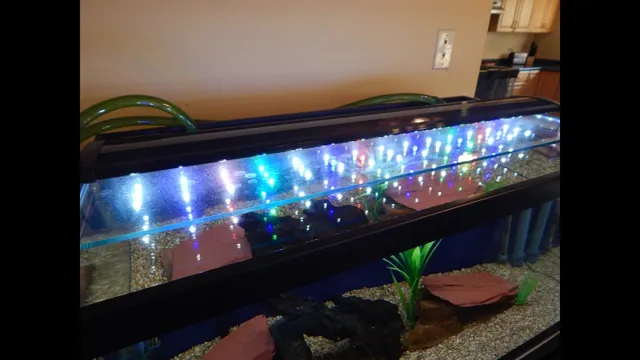
Screwdriver
When it comes to DIY projects or quick household fixes, having a good old screwdriver can definitely come in handy. But, what do you need to make sure you have on hand before diving into any projects that require one? Firstly, you’ll need a good quality screwdriver with interchangeable heads to ensure you can use it on various screw types and sizes. It’s also important to have a selection of screws on hand, so that you can ensure you have the right size required for the job at hand.
If you’re looking to remove screws, a pair of pliers can also come in handy. Additionally, having a magnetic wristband can make life a lot easier by helping keep screws in one place while you work. Lastly, it’s important to consider safety and have on hand a pair of safety glasses to prevent any debris from flying into your eyes while working.
With these simple tools, you’ll be ready to tackle any project that comes your way!
Rubbing alcohol
Rubbing alcohol is a versatile household item that can be used for a variety of purposes. To start, you’ll need a bottle of rubbing alcohol that has at least a 70% concentration. This ensures that the alcohol is effective in killing germs and bacteria.
Additionally, you may need some cotton balls or pads for application purposes, a spray bottle for creating a solution, and a small container for soaking small items. With these simple supplies, you can use rubbing alcohol for cleaning surfaces, disinfecting wounds, and removing stubborn stains like ink or grease. It can also be used as a natural insect repellent or to quickly dry out wet electronics.
When using rubbing alcohol, it’s important to handle it carefully, as it is highly flammable. Keep it away from open flames or heat sources and be sure to read all warning labels before use. With these precautions in mind, rubbing alcohol can be an effective and affordable solution for a variety of household needs.
Preparation
Are you looking to replace the LED in your aquarium hood? Before you start, make sure you have all the necessary tools and a new LED that is compatible with your aquarium hood. You will need a screwdriver, pliers, and a replacement LED. Ensure that you turn off the power to your aquarium before starting the replacement process to avoid any accidents.
It is also important to check the manufacturer’s instructions for any specific guidance on changing the LED. Once everything is prepared, carefully remove the old LED from the aquarium hood. You may need to use pliers if it is difficult to remove.
Then, insert the new LED in place, lining up the pins with the holes. Finally, fasten it in with screws. You can now turn the power back on and enjoy the new, brighter lighting in your aquarium.
Remember to dispose of the old LED responsibly and enjoy your refreshed aquarium display. (See Also: How to Make a Clear Lid for an Aquarium: Step-by-Step Guide to Ensure Optimum Visibility.)
Turn off all electricity to your aquarium hood
When it comes to preparing your aquarium for maintenance or cleaning, one of the most important steps is to turn off all electricity to the aquarium hood. This not only ensures safety for you, but also protects the fish and other aquatic life inside the tank. Before handling any equipment or reaching into the tank, make sure that you have turned off all power sources to the hood, including any heaters, filters, and lights.
This will prevent accidental electrocution or damage to the equipment, and also give you a clearer view of the tank. Think of it as similar to turning off the power to a light switch before changing a bulb – it’s always better to be safe than sorry. By taking this simple step, you can ensure a safer and more efficient aquarium maintenance experience.
Clean the area where the LED will be installed with rubbing alcohol
Preparing the area where the LED will be installed is an essential step to ensure a successful installation. To start, clean the area with rubbing alcohol to remove dust or other particles that may interfere with the adherence of the LED. Rubbing alcohol is an excellent disinfectant that can also remove any grime, grease, or oils that may stick on the surface.
Using a clean, lint-free cloth, pour some rubbing alcohol and carefully wipe the area where you plan to install your LED. Make sure to cover every corner and crevice to ensure a completely clean area. A well-prepared surface guarantees that your LED will adhere to the surface securely, making it last longer and function correctly.
By following the simple preparation steps and using rubbing alcohol, you can ensure that your LED installation will be successful, and your space will look better than ever!
Removing the Old LED
When it comes to changing the LED in your aquarium hood, the first step is removing the old one. This can sometimes be a bit tricky, especially if the LED is tightly secured in place. Before you begin, make sure to turn off all power to the aquarium to avoid any potential accidents.
Then, carefully examine the LED to see how it is attached. Some LEDs are screwed into place, while others may be secured with clips or adhesive. Once you have figured out how the LED is attached, you can carefully remove it using a screwdriver or gently pulling it with your hands.
Be sure to dispose of the old LED properly and safely, and then you can move on to installing the new one. Remember, the key to successfully changing your aquarium hood LED is patience and attention to detail.
Use a screwdriver to remove the screws holding the old LED in place
When it comes to removing the old LED, the first step is to equip yourself with a screwdriver. This tool will be used to remove the screws holding the old LED in place. It’s imperative to use the right size and type of screwdriver to avoid damaging the device.
Failure to remove the screws properly may cause other issues that could affect the functionality of the device. Be very careful and maintain focus as you remove the screws – don’t rush the process. After you have removed all the screws, the old LED should come off easily.
Remember, safety comes first, so it’s recommended to wear safety gloves and goggles to protect your hands and eyes. Following this methodical approach will ensure a successful removal of the old LED without creating any long-term damage.
Disconnect the old LED from the power source
If you’re replacing an old LED, the first step is to disconnect it from the power source. You don’t want to risk electrocution or any damage to your new LED. Make sure you turn off the power supply completely before removing the old LED.
You can do this by switching off the breaker or unplugging it from the socket. If the LED is attached to a power cord, unplug it from the wall or the power source. Then, examine the LED and locate any screws or bolts that are holding it in place.
Remove these screws or bolts, and then gently pull the LED out of its socket. Be careful not to damage any of the wiring as you’re removing the LED. Once you’ve removed it, be sure to discard it properly.
With the old LED safely discarded, you’ll now be ready to install your new LED and connect it to the power source.
Installing the New LED
When it’s time to change the LED in your aquarium hood, don’t fret! With just a few simple steps, you can have your fish tank fully equipped with a new, bright light source. First, make sure to turn off all power to the aquarium before beginning any work. Once you’ve done this, remove the old LED by gently twisting and pulling it out of its socket. (See Also: How to Hide Filter and Heater in Aquarium: Tips and Tricks to Keep Your Tank Looking Pristine.)
Then, carefully insert the new LED into the socket, making sure it fits snugly in place. Finally, turn the power back on and voila! Your fish will have a beautiful, brightly-lit home once again. Remember to dispose of the old LED properly and wash your hands thoroughly after handling the new one.
With these steps, you’ll be a pro at changing the LED in your aquarium hood!
Connect the new LED to the power source
When it comes to installing a new LED light, connecting it to the power source is a crucial step. First, make sure to turn off the power source before beginning any work to avoid electrocution. Then, identify which wires connect to the LED and which connect to the power source.
Most LED lights come with a red wire and a black wire – the red wire is the positive wire, and the black wire is the negative wire. The red wire should be connected to the positive terminal of the power source, and the black wire should be connected to the negative terminal. Once the wires are securely connected, turn the power source back on and test the LED to ensure it’s working correctly.
With the LED properly connected to the power source, you can now enjoy the energy-saving benefits and bright illumination that LED lights can bring to your space.
Secure the new LED in place with screws
After removing the old LED, it is time to install the new one. You want to make sure it is securely in place, so you don’t have to worry about it falling out later. To do this, grab your screws and screwdriver.
Most LEDs come with screws specifically designed for them, so make sure you use the ones that came with your new LED. Position the LED in its slot, making sure it is lined up correctly. Once you are happy with the positioning, take your screwdriver and gently screw in the screws, being careful not to over-tighten them.
Over-tightening can cause damage to the LED or the surrounding circuit board, which is the last thing you want. Once all of the screws are in place and secure, give the LED a gentle wiggle to make sure it is snug and not loose. You’re now ready to move on to the next step in your project!
Testing the New LED
If you’ve noticed that your aquarium hood’s LED has burnt out and needs to be replaced, fear not, as it’s a relatively simple process. First things first, make sure the aquarium’s power supply is turned off and the tank is unplugged to avoid any accidents. Then, locate the LED panel in the aquarium hood and remove it from the fixture.
Next, carefully remove the old LED from the panel, taking note of its position, and replace it with the new LED. Once the new LED is securely in place, reattach the panel to the fixture and turn the power supply back on to ensure it’s working as it should. Making small changes like this can greatly enhance the viewing experience of your aquarium’s inhabitants, so don’t be afraid to give it a try.
Turn on the electricity to the aquarium hood
Once you’ve set up your aquarium and filled it with water, the next step is to turn on the electricity to the aquarium hood. This will power the LED lights that come with most hoods and allow you to see your fish and plants in all their glory. But before you turn on the electricity, it’s important to make sure everything is actually working properly.
One of the best ways to check is to test the new LED lights. Simply turn on the hood, and take a few moments to observe the light levels and colors of your aquarium. This is also a great time to adjust the light intensity if necessary, or even upgrade to more powerful LED lights if you need more illumination.
Don’t forget to use a high-quality surge protector to keep your aquarium safe from electrical damage in case of a power outage or surge. With a little patience and attention to detail, you can enjoy a beautiful and healthy aquarium in your home or office.
Check that the new LED is working properly
Testing the new LED is an integral step after installing it in your project. A quick and straightforward way to check if the LED works correctly is to hook it up to a power source and check if it turns on. If it does not light up, there may be a problem with the wiring or the LED itself.
In such cases, you can try disconnecting and reconnecting the wires or replacing the LED with a new one. If the LED lights up, you can further test it by using a multimeter to ensure that it is receiving the right amount of voltage and current. Additionally, you can try dimming the LED to confirm that it can operate at different levels of brightness.
By testing your new LED, you can ensure that it is working correctly before integrating it into your final circuit, saving you the hassle of troubleshooting later on. (See Also: How to Breed Arowana in Aquarium: Tips and Tricks for Successful Breeding)
Conclusion
In conclusion, changing the LED in your aquarium hood may seem daunting at first, but it’s actually quite simple. All you need is a replacement LED, some basic tools, and a little bit of know-how. With these steps, you’ll have a brighter, more vibrant aquarium in no time – and who knows, maybe even attract some envious looks from your fish neighbors.
So don’t be afraid to dive in and upgrade your tank’s lighting system – after all, a well-lit aquarium is a happy aquarium!”
Changing the LED in your aquarium hood is a simple process that can enhance the beauty of your tank. Following these steps will ensure your aquarium lighting is working properly.
Testing the new LED in your aquarium lighting system is an essential part of the process. It ensures that your aquarium is getting the right amount of light and is running efficiently. After installing the new LED, it’s important to test it to make sure it’s working correctly.
Turn off all the other lights in your room and plug in the LED. Observe the brightness and color of the light. If it’s too bright or too dim, you may have to adjust the wattage of the light.
Additionally, check to see if the color of the light is appropriate for the type of aquatic plants and animals in your tank. A cool white color is best for fish-only tanks, while a warm white color is ideal for planted tanks. Testing the new LED can also help you identify any issues before they become bigger problems.
Use your judgement to determine if there is anything else you need to adjust to support your aquarium’s health. By testing the new LED, you can ensure that your aquarium is working properly and that your fish and plants will thrive.
FAQs
What tools do I need to change the LED lights in my aquarium hood?
You will need a screwdriver, wire snips, and replacement LED lights.
Can I replace my aquarium hood LED lights with any type of LED lights?
No, you must use LED lights that are specifically designed for aquariums and have the correct spectrum for plant and fish growth.
How do I know if my aquarium hood LED lights need to be replaced?
If the lights appear dim or have stopped working completely, it may be time to replace them.
Can I replace just one LED light if it has stopped working?
Yes, you can replace individual LED lights if necessary.
How do I remove the old LED lights from my aquarium hood?
Use wire snips to cut the wires connecting the old LED lights to the power source, then use a screwdriver to remove the old lights from the hood.
How do I install the new LED lights in my aquarium hood?
Connect the new LED lights to the power source using wire crimps or electrical tape, then screw the new lights into place in the hood.
How often do I need to replace the LED lights in my aquarium hood?
LED lights can often last for several years, but it’s recommended to replace them every 2-3 years for optimal performance.

